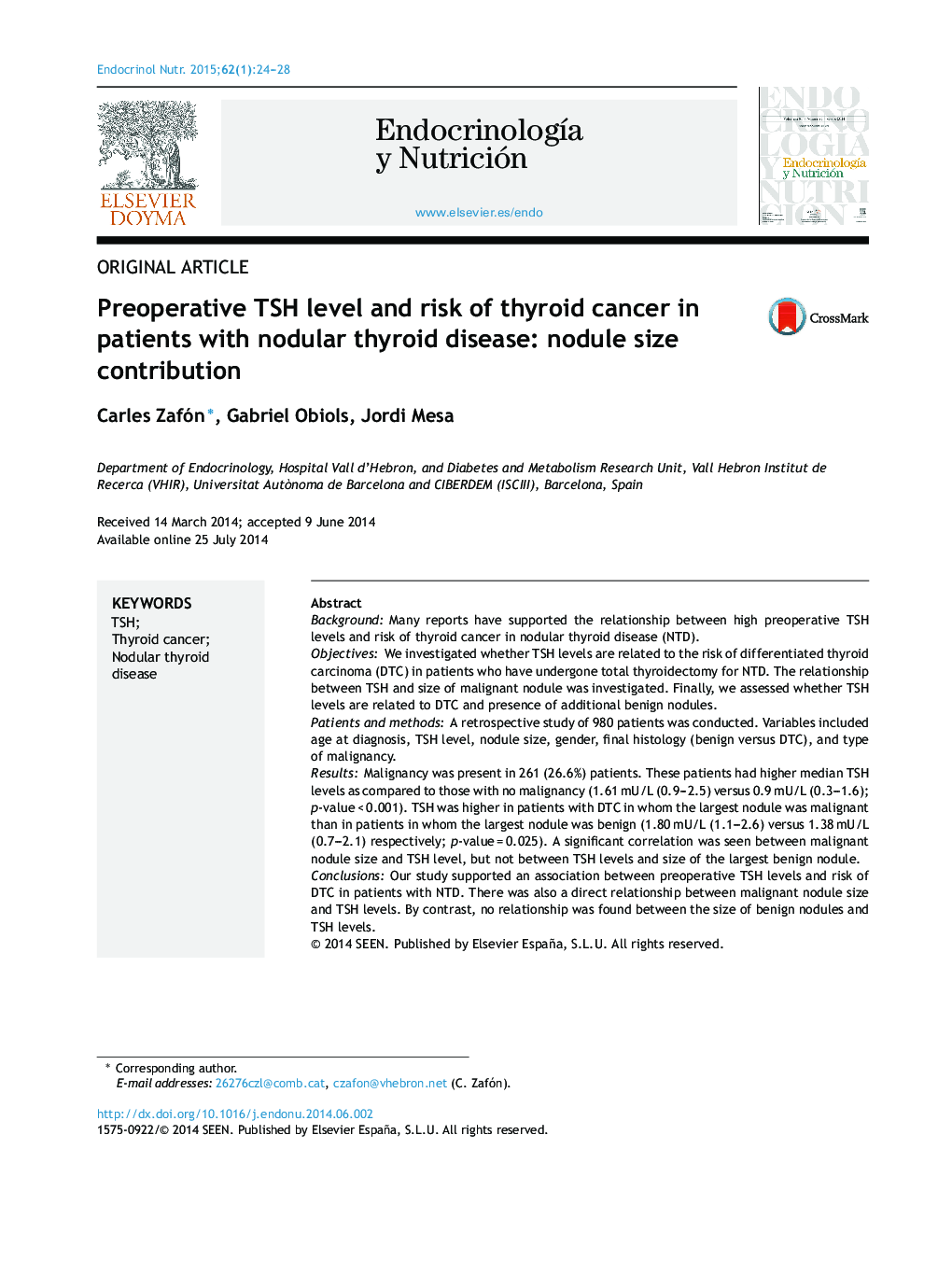| Article ID | Journal | Published Year | Pages | File Type |
|---|---|---|---|---|
| 2773427 | Endocrinología y Nutrición | 2015 | 5 Pages |
BackgroundMany reports have supported the relationship between high preoperative TSH levels and risk of thyroid cancer in nodular thyroid disease (NTD).ObjectivesWe investigated whether TSH levels are related to the risk of differentiated thyroid carcinoma (DTC) in patients who have undergone total thyroidectomy for NTD. The relationship between TSH and size of malignant nodule was investigated. Finally, we assessed whether TSH levels are related to DTC and presence of additional benign nodules.Patients and methodsA retrospective study of 980 patients was conducted. Variables included age at diagnosis, TSH level, nodule size, gender, final histology (benign versus DTC), and type of malignancy.ResultsMalignancy was present in 261 (26.6%) patients. These patients had higher median TSH levels as compared to those with no malignancy (1.61 mU/L (0.9–2.5) versus 0.9 mU/L (0.3–1.6); p-value < 0.001). TSH was higher in patients with DTC in whom the largest nodule was malignant than in patients in whom the largest nodule was benign (1.80 mU/L (1.1–2.6) versus 1.38 mU/L (0.7–2.1) respectively; p-value = 0.025). A significant correlation was seen between malignant nodule size and TSH level, but not between TSH levels and size of the largest benign nodule.ConclusionsOur study supported an association between preoperative TSH levels and risk of DTC in patients with NTD. There was also a direct relationship between malignant nodule size and TSH levels. By contrast, no relationship was found between the size of benign nodules and TSH levels.
ResumenAntecedentesUn gran número de artículos han confirmado la relación entre los niveles elevados de TSH preoperatoria y el riesgo de cáncer de tiroides en la enfermedad nodular tiroidea (ENT).ObjetivosAnalizamos si los valores de TSH preoperatoria se relacionan con el riesgo de cáncer diferenciado de tiroides (CDT) en pacientes tiroidectomizados por ENT. Además, investigamos la relación entre TSH y el tamaño del nódulo maligno. Finalmente, valoramos si la TSH se relaciona con la presencia de CDT y con la presencia de nódulos benignos adicionales.Pacientes y métodosSe estudiaron retrospectivamente 980 pacientes. Las variables consideradas fueron: edad al diagnóstico, sexo, valor de TSH, tamaño del nódulo, histología definitiva y tipo de CDT.ResultadosEn 261 (26,6%) casos el diagnóstico fue de CDT. Estos pacientes tenían niveles más elevados de TSH que los pacientes con histología benigna (mediana de 1,61 mU/l [0,9-2,5] versus 0,9 mU/l [0,3-1,6]; p < 0,001). La TSH fue más elevada en pacientes con CDT en los que el nódulo dominante fue maligno en relación con los que el nódulo dominante fue benigno (1,80 mU/l [1,1-2,6] versus 1,38 mU/l [0,7-2,1], p = 0,025). Hubo una correlación significativa entre el tamaño del nódulo maligno y la TSH, pero no entre la TSH y el tamaño del nódulo benigno dominante.ConclusionesConfirmamos la asociación entre los niveles preoperatorios de TSH y el riesgo de CDT en la ENT. Describimos una relación directa entre el tamaño del nódulo maligno y los valores de TSH. Esta relación no se confirma para el tamaño de los nódulos benignos adicionales.
